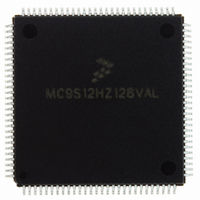MC9S12HZ128VAL Freescale Semiconductor, MC9S12HZ128VAL Datasheet - Page 577

MC9S12HZ128VAL
Manufacturer Part Number
MC9S12HZ128VAL
Description
IC MCU 16BIT 2K FLASH 112-LQFP
Manufacturer
Freescale Semiconductor
Series
HCS12r
Datasheet
1.MC9S12HZ128CAL.pdf
(692 pages)
Specifications of MC9S12HZ128VAL
Core Processor
HCS12
Core Size
16-Bit
Speed
25MHz
Connectivity
CAN, EBI/EMI, I²C, SCI, SPI
Peripherals
LCD, Motor control PWM, POR, PWM, WDT
Number Of I /o
85
Program Memory Size
128KB (128K x 8)
Program Memory Type
FLASH
Eeprom Size
2K x 8
Ram Size
6K x 8
Voltage - Supply (vcc/vdd)
2.35 V ~ 5.5 V
Data Converters
A/D 16x10b
Oscillator Type
Internal
Operating Temperature
-40°C ~ 105°C
Package / Case
112-LQFP
Processor Series
S12H
Core
HCS12
Data Bus Width
16 bit
Data Ram Size
6 KB
Interface Type
I2C/SCI/SPI
Maximum Clock Frequency
50 MHz
Number Of Programmable I/os
85
Number Of Timers
8
Maximum Operating Temperature
+ 105 C
Mounting Style
SMD/SMT
3rd Party Development Tools
EWHCS12
Minimum Operating Temperature
- 40 C
On-chip Adc
16-ch x 10-bit
Lead Free Status / RoHS Status
Lead free / RoHS Compliant
Available stocks
Company
Part Number
Manufacturer
Quantity
Price
Company:
Part Number:
MC9S12HZ128VAL
Manufacturer:
Freescale Semiconductor
Quantity:
10 000
Part Number:
MC9S12HZ128VAL
Manufacturer:
FREESCALE
Quantity:
20 000
- Current page: 577 of 692
- Download datasheet (4Mb)
21.1.2
21.2
In typical implementations, the MEBI sub-block of the core interfaces directly with external system pins.
Some pins may not be bonded out in all implementations.
Table 21-1
of these pins and associated pull-ups or pull-downs is dependent on the mode of operation and on the
integration of this block at the chip level (chip dependent).
Freescale Semiconductor
•
•
•
•
•
•
•
•
Normal expanded wide mode
Ports A and B are configured as a 16-bit multiplexed address and data bus and port E provides bus
control and status signals. This mode allows 16-bit external memory and peripheral devices to be
interfaced to the system.
Normal expanded narrow mode
Ports A and B are configured as a 16-bit address bus and port A is multiplexed with 8-bit data.
Port E provides bus control and status signals. This mode allows 8-bit external memory and
peripheral devices to be interfaced to the system.
Normal single-chip mode
There is no external expansion bus in this mode. The processor program is executed from internal
memory. Ports A, B, K, and most of E are available as general-purpose I/O.
Special single-chip mode
This mode is generally used for debugging single-chip operation, boot-strapping, or security
related operations. The active background mode is in control of CPU execution and BDM firmware
is waiting for additional serial commands through the BKGD pin. There is no external expansion
bus after reset in this mode.
Emulation expanded wide mode
Developers use this mode for emulation systems in which the users target application is normal
expanded wide mode.
Emulation expanded narrow mode
Developers use this mode for emulation systems in which the users target application is normal
expanded narrow mode.
Special test mode
Ports A and B are configured as a 16-bit multiplexed address and data bus and port E provides bus
control and status signals. In special test mode, the write protection of many control bits is lifted
so that they can be thoroughly tested without needing to go through reset.
Special peripheral mode
This mode is intended for Freescale Semiconductor factory testing of the system. The CPU is
inactive and an external (tester) bus master drives address, data, and bus control signals.
External Signal Description
outlines the pin names and functions and gives a brief description of their operation reset state
Modes of Operation
MC9S12HZ256 Data Sheet, Rev. 2.05
Chapter 21 Multiplexed External Bus Interface (MEBIV3)
577
Related parts for MC9S12HZ128VAL
Image
Part Number
Description
Manufacturer
Datasheet
Request
R
Part Number:
Description:
Manufacturer:
Freescale Semiconductor, Inc
Datasheet:
Part Number:
Description:
Manufacturer:
Freescale Semiconductor, Inc
Datasheet:
Part Number:
Description:
Manufacturer:
Freescale Semiconductor, Inc
Datasheet:
Part Number:
Description:
Manufacturer:
Freescale Semiconductor, Inc
Datasheet:
Part Number:
Description:
Manufacturer:
Freescale Semiconductor, Inc
Datasheet:
Part Number:
Description:
Manufacturer:
Freescale Semiconductor, Inc
Datasheet:
Part Number:
Description:
Manufacturer:
Freescale Semiconductor, Inc
Datasheet:
Part Number:
Description:
Manufacturer:
Freescale Semiconductor, Inc
Datasheet:
Part Number:
Description:
Manufacturer:
Freescale Semiconductor, Inc
Datasheet:
Part Number:
Description:
Manufacturer:
Freescale Semiconductor, Inc
Datasheet:
Part Number:
Description:
Manufacturer:
Freescale Semiconductor, Inc
Datasheet:
Part Number:
Description:
Manufacturer:
Freescale Semiconductor, Inc
Datasheet:
Part Number:
Description:
Manufacturer:
Freescale Semiconductor, Inc
Datasheet:
Part Number:
Description:
Manufacturer:
Freescale Semiconductor, Inc
Datasheet:
Part Number:
Description:
Manufacturer:
Freescale Semiconductor, Inc
Datasheet:











